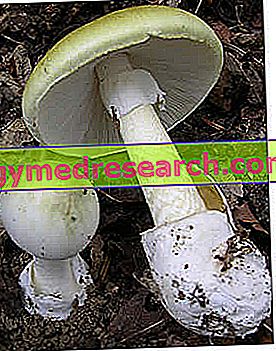Hazard of the Amanita Phalloides
Subtle and equivocal, the Amanita phalloides is the progenitor of the highly deadly poisonous mushrooms: its ingestion causes serious poisoning syndromes, with ominous results in the vast majority of cases (death in 70-80%). The Amanita phalloides causes death even after the only half-cap of the mushroom is swallowed: in this regard, in similar situations, it can be stated that the maxim of Paracelsus ("it is the dose that makes the poison ") is not validly confirmed practical.

Synonyms
In common parlance, the Amanita phalloides is known by the most diverse names: angel of death, ovolo bastardo, Agaricus phalloides, Tignosa verdognola and Tignusa morteada. The name of the species (phalloides) consists of two Greek words: phallòs (phallus) and eîdos (form), an appellation that is perfectly suited to the fungus, given the characteristic phallic conformation of the stem.
Botanical description
The extremely dangerous Amanita phalloides is a mushroom with a thousand forms; however, it has specific features, listed below:
- The hat exhibits a bell-shaped or conical shape, sometimes hemispherical, varying in color from gray to yellowish, and from brownish to white. In general, the color of the fungus fades with ever lighter shades from the center to the margin. The diameter of the cap varies from 4 to 15 cm and can be shiny or viscous based on humidity.
- The phallic stem of Amanita phalloides, which tends to widen as it goes down, appears with very particular whitish or greenish streaks, comparable to snakeskin. The stem of Amanita phalloides is full when young, and hollow in the old fungus, but always bulbous at the base.
- The lamellae of the fungus are very thick and unequal, free at the stem.
- The ring, located in the pre-apical zone, is white, and wraps the stem like a handkerchief: in the mature mushroom, the ring tends to fall.
The meat of Amanita phalloides is markedly fibrous, white and firm. When raw, the smell is zero, sometimes accentuated by notes of dried rose or urine; the soggy fungus on the other hand emanates a very unpleasant and fetid odor, similar to ammonia.
The angel of death grows easily in the leafy woods, near oaks and conifers, especially in the summer and autumn months.
Toxic chemical components
The toxicity of Amanita phalloides is due to two chemical constituents: amantine and phalloidins. The amantines (alpha and beta) are cyclic peptides responsible for the selective blocking of the enzyme Rna-polymerase: the average lethal dose (LD50) of the amantines is 0.1 mg / kg [from A reasoned herbalist and phytotherapy dictionary, of A Bruni, M. Nicoletti]; phalloidins, mycotoxins with a peptide cycle structure are responsible for liver and gastrointestinal damage, caused by the inhibition of DNA transcription in liver cells. [taken from wikipedia /]
The heat treatment does not kill toxins: it is, in fact, thermostable substances, therefore also resistant to cooking.
Phalloid poisoning syndrome
In 70-80% of cases, the fungus causes death: it is estimated that one milligram per kilogram of body weight is sufficient to generate irreversible damage to the liver. The first symptoms are felt only 6-12 hours after taking the fungus, other times the signs of poisoning can occur even after 40 hours. Amanita phalloides intoxication consists of four distinct phases: the time frame coinciding with the incubation of the toxin is called the "latency phase", a period in which the poisonous molecule remains latent in the body. It is precisely the long interval of "waiting" before the manifestation of symptoms that complicates the clinical picture, which is very negatively affected by the lack of timely intervention.
After 12-40 hours, the first gastrointestinal disorders begin, mainly characterized by uncontrollable vomiting, excessive sweating, diarrhea and severe abdominal pain (gastrointestinal phase). At this stage, serious and possibly serious complications are possible, such as dehydration associated with hypovolemia, acute renal failure and, sometimes, death.
The third phase (hepatic) shows an exaggerated increase in the transaminase and bilirubin, with possible internal bleeding.
The phase preceding death (severe liver failure) occurs 4-5 days after the intake of Amanita phalloides, and is characterized by very low values of prothrombin activity and hepatic necrosis, hepatic coma, generally associated with respiratory failure, coagulopathy, convulsions and respiratory failure.
Remedies against poisoning
When Amanita phalloides intoxication is diagnosed promptly (which is rather difficult, given that the symptoms appear after many hours), the death of the subject can be averted. However, even if the patient survives Amanita phalloides poisoning, he will most likely have to undergo liver transplantation and / or dialysis.
The timely intervention includes gastric lavage - in order to remove traces of toxin from the stomach and from the intestine - administration of activated carbon, able to absorb the poisonous molecules, forced diuresis, hemodialysis, plasmapheresis. Probably, some substances such as thioctic acid, silymarin and acubin are possible antidotes, to be administered, clearly, as soon as possible after taking Amanita phalloides.
Amanita phalloides: how to recognize it
To identify and ascertain having collected Amanita phalloides, there is a rather simple method: after having crushed a piece of mushroom in a sheet of newsprint, drop a few drops of muriatic acid on the impression left, paying attention to mark it with a pencil the contour before the moisture left by the fungus dries. The formation of a bluish halo after 5-10 minutes is a sign of the presence of amatoxin: in doing so, confirmation will be given that the fungus is the very poisonous Amanita phalloides.
Amanita phalloides summary »



